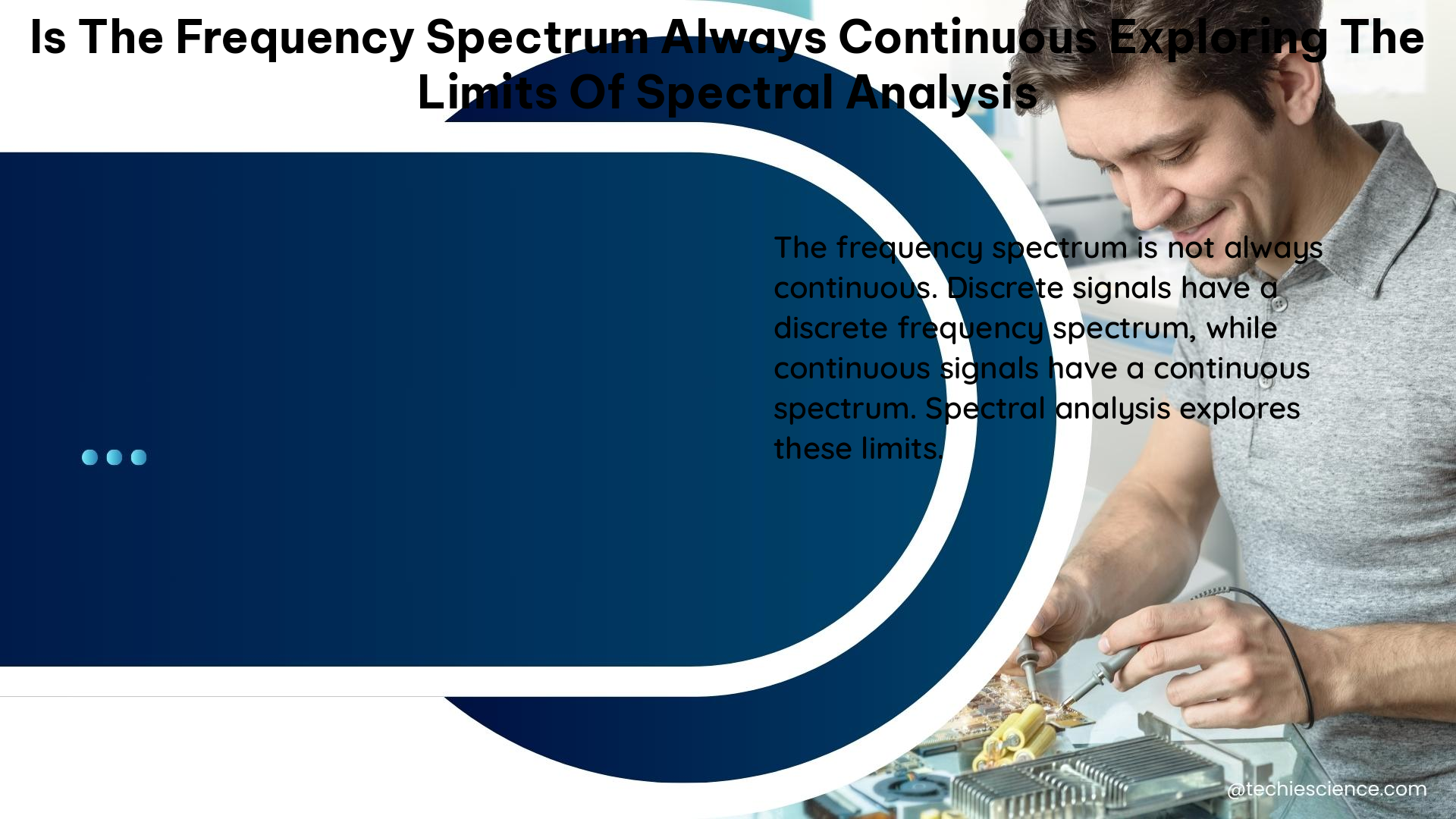The frequency spectrum of a signal can be either continuous or discrete, depending on the nature of the signal. Continuous signals, such as those generated by analog devices, typically have a continuous frequency spectrum, while discrete-time signals, such as those generated by digital systems, have a discrete frequency spectrum. However, the limits of spectral analysis can be explored by using various techniques, such as windowing and zero-padding, which can provide a more detailed view of the frequency spectrum.
Understanding Continuous and Discrete Frequency Spectra
The frequency spectrum of a signal represents the distribution of the signal’s energy across different frequencies. For a continuous-time signal, the frequency spectrum is a continuous function of frequency, meaning that the signal’s energy can be distributed across a continuous range of frequencies. In contrast, the frequency spectrum of a discrete-time signal is a discrete function of frequency, with the signal’s energy concentrated at specific, discrete frequencies.
The distinction between continuous and discrete frequency spectra is important because it affects the way we analyze and process signals. Continuous frequency spectra require different mathematical tools and techniques than discrete frequency spectra, and the choice of analysis method can have a significant impact on the accuracy and resolution of the results.
Techniques for Exploring the Limits of Spectral Analysis

To explore the limits of spectral analysis, researchers and engineers often employ various techniques, such as windowing and zero-padding. These techniques can help to provide a more detailed and accurate view of the frequency spectrum, even in cases where the signal’s frequency content is not easily discernible.
Windowing
Windowing is a technique used to improve the frequency resolution and selectivity of a signal’s frequency spectrum. The process involves multiplying the input signal by a window function, which is a mathematical function that smooths the signal’s edges and reduces the effects of spectral leakage.
There are several different window functions available, each with its own unique characteristics and trade-offs. Some of the most commonly used window functions include:
- Hanning Window: This window function provides a good balance between frequency resolution and sidelobe suppression, making it a popular choice for many applications.
- Blackman Window: The Blackman window has excellent sidelobe rejection, making it well-suited for analyzing signals with very different amplitude levels.
- 7-term Blackman-Harris Window: This window function has even better sidelobe rejection than the standard Blackman window, making it particularly useful for analyzing signals with complex frequency content.
- Flat-top Window: The flat-top window is designed to provide high amplitude accuracy, but at the cost of slightly reduced frequency resolution.
The choice of window function depends on the specific requirements of the application, such as the desired frequency resolution, sidelobe suppression, and amplitude accuracy.
Zero-Padding
Zero-padding is a technique used to increase the frequency resolution of a signal’s frequency spectrum. It involves adding zeros to the end of the input signal, effectively increasing the length of the signal without adding any new information. This, in turn, increases the number of frequency bins in the resulting frequency spectrum, providing a more detailed view of the signal’s frequency content.
Zero-padding can be particularly useful when analyzing signals with narrow-band frequency components, as it can help to better resolve these components and provide more accurate measurements of their frequency and amplitude.
Measuring the Frequency Spectrum with FFT Analyzers
When it comes to measuring the frequency spectrum of a signal, FFT (Fast Fourier Transform) analyzers are commonly used. These devices produce frequency domain data in the form of power spectra and cross-power spectra, which provide valuable insights into the frequency content of the signal.
The process of obtaining these spectra involves several steps:
- Sampling Input Time Data: The input signal is sampled at a specific rate, converting the continuous-time signal into a discrete-time signal.
- Transforming Time Blocks: The sampled input time data is divided into smaller time blocks, which are then transformed into the frequency domain using the FFT algorithm.
- Calculating Power Spectra: The power spectra are calculated by averaging the instantaneous complex FFT spectra over a specified number of spectra or a time duration.
The resulting power spectra and cross-power spectra provide a quantitative representation of the signal’s frequency content, allowing researchers and engineers to analyze the signal’s characteristics in detail.
Conclusion
While the frequency spectrum of a signal can be either continuous or discrete, the limits of spectral analysis can be explored through the use of various techniques, such as windowing and zero-padding. These techniques can provide a more detailed and accurate view of the signal’s frequency content, enabling researchers and engineers to gain valuable insights into the nature of the signal and its frequency characteristics.
By understanding the principles of continuous and discrete frequency spectra, as well as the various tools and techniques available for spectral analysis, professionals in the field of electronics and signal processing can better analyze and interpret the frequency-domain characteristics of the signals they work with, leading to more informed decision-making and more effective problem-solving.
References:
- Spectral density – Wikipedia
- Unveiling the Power of Spike’s Swept Analysis Mode in RF Engineering
- Lectures on Spectra of Continuous-Time Signals
- Frequency spectrum of a signal – an overview | ScienceDirect Topics
- Guide to FFT Analysis (Fast Fourier Transform) | Dewesoft

The lambdageeks.com Core SME Team is a group of experienced subject matter experts from diverse scientific and technical fields including Physics, Chemistry, Technology,Electronics & Electrical Engineering, Automotive, Mechanical Engineering. Our team collaborates to create high-quality, well-researched articles on a wide range of science and technology topics for the lambdageeks.com website.
All Our Senior SME are having more than 7 Years of experience in the respective fields . They are either Working Industry Professionals or assocaited With different Universities. Refer Our Authors Page to get to know About our Core SMEs.